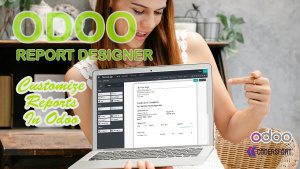Creating Professional Reports in Odoo: A Guide to the Report Designer
- July 3, 2024
- Uncategorized
In today’s data-driven world, having accurate and customizable reports is crucial for businesses. Odoo Report Designer is a versatile tool that allows you to create, modify, and customize reports to fit your unique business needs. In this blog post, we will explore the features, benefits, and a step-by-step guide on how to use Odoo Report Designer effectively.

Odoo Report Designer
What is Odoo Report Designer?
Odoo Report Designer is a module within the Odoo suite that enables users to create and customize reports. This tool is designed to be user-friendly while offering powerful features for advanced users. It supports various formats such as PDF, HTML, and Excel, making it easy to generate reports that meet different business requirements.
Key Features of Odoo Report Designer
- Drag-and-Drop Interface: The intuitive drag-and-drop interface allows users to design reports without needing extensive technical knowledge.
- Customizable Templates: Start with predefined templates and modify them to match your branding and reporting needs.
- Dynamic Data Fields: Easily insert dynamic data fields that automatically update with the latest information.
- Multi-Format Support: Export reports in various formats including PDF, HTML, and Excel.
- Integration with Odoo Modules: Seamlessly integrates with other Odoo modules, pulling data directly from your Odoo database.
Benefits of Using Odoo Report Designer
- Efficiency: Save time by generating reports quickly with the drag-and-drop interface and customizable templates.
- Accuracy: Ensure data accuracy by pulling real-time information from your Odoo database.
- Customization: Tailor reports to meet specific business needs and branding guidelines.
- Cost-Effective: Reduce the need for third-party reporting tools, cutting down on additional costs.
How to Use Odoo Report Designer: A Step-by-Step Guide
Step 1: Accessing the Report Designer
To get started, navigate to the Odoo Report Designer module from your Odoo dashboard. Ensure you have the necessary permissions to access and modify reports.
Step 2: Choosing a Template
Select a template that closely matches the type of report you want to create. Odoo offers a variety of templates for different business scenarios.
Step 3: Customizing the Template
- Add Data Fields: Drag and drop data fields from the sidebar to the desired location on the template.
- Formatting: Customize the appearance of your report by changing fonts, colors, and layout.
- Dynamic Content: Insert dynamic content that will update automatically with your database information.
Step 4: Preview and Test
Before finalizing your report, use the preview function to ensure everything is displaying correctly. Make adjustments as needed.
Step 5: Exporting and Sharing
Once you’re satisfied with the design, export the report in your desired format. You can then share it with stakeholders or schedule automated reports.
Buy from our app store or
Contact us directly to learn more or request a live demo.
About us and this blog
We are a digital marketing company with a focus on helping our customers achieve great results across several key areas.
Request a free quote
We offer professional SEO services that help websites increase their organic search score drastically in order to compete for the highest rankings even when it comes to highly competitive keywords.

